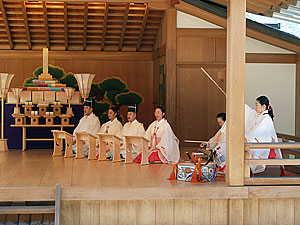
By Bill Roberts
Once upon a time, Susanoo no Mikoto, brother of the Sun Goddess, slew an eight-tailed dragon and rescued a beautiful maiden named Kushinadahime, and her parents. To show their gratitude the parents offered their daughter’s hand in marriage to Susanoo no Mikoto. (Who wouldn’t want their daughter to marry a hero from the divine family?)
And so it came to pass that Susanoo no Mikoto married Kushinadahime, built a grand palace and brought peace to the land. To celebrate the event he composed a beautiful poem. They would have lived happily ever after except Susanoo no Mikoto was a better poet-warrior than he was a ruler. Administering his new land wore him down.
Like any good wife, Kushinadahime knew what it took to help her husband relax. She played music for him by plucking on a bowstring with an arrowhead. She also fastened the bowstring to the bottom of a wooden tub and beat it with a stick.
And so we see the mythical beginnings not only of Japanese poetry but also of the two-string yakumokoto and the bow drum. Poetry, the two instruments and the myth itself are at the heart of the Utamatsuri, or traditional poetry festival, which may be the most colorful and dramatic of all Oomoto rituals. I attended an Utamatsuri on Nov. 16, 2002. It was held to celebrate the 50th anniversary of the founding of the Oomoto branch in Tokushima on the island of Shikoku.
The ancient Japanese would gather to recite or chant poems as a form of entertainment. The festivals were often held at a shrine, on top of a mountain, beside a river or in the market place. Perpetuating this Japanese folk art is another example of how Oomoto melds traditional arts with spiritual practice.
Onisaburo Deguchi, the Co-Founder of Oomoto, revived the Utamatsuri in 1935. In his lifetime, Onisaburo wrote thousands of the 5-line, 31-sylable tanka, which is the Utamatsuri’s poetic form. Many Oomoto followers write tanka and submit their work to a monthly journal. For years, Oomoto has performed an Utamatsuri each August as part of its Summer Festival, held in Kameoka to celebrate the anniversary of Onisaburo’s birth.
The festival in Tokushima was the first one held at an Oomoto branch. As an indication of the importance of the event, Mme. Kurenai Deguchi, the Spiritual Leader, was present.
The Tokushima festival was held outdoors on the Oomoto grounds. The air was full of expectancy as a couple of hundred people took their seats. It was a balmy night with a cloud-mottled sky just a few days before the full moon. Shadows danced on the makeshift stage surrounded by pines.
As dusk settled, five priests and the seven-member chorus marched to the stage under torchlight, accompanied by a yakumokoto and a bow drum. On the stage a special altar held a pyramid of 46 colorful cards, each containing a poem. They were chosen from 215 submitted by Oomoto followers.
Kneeling at the altar, the chief priest opened the festival by reading a sacred poem to invoke the presence of Susanoo no Mikoto. Next, three young women, symbolizing Kushinadahime and her parents, marched onto the stage carrying clusters of bells to perform a purification dance. They moved around slowly, ringing their bells, accompanied by the koto, the bow drum and one chanter.
When the three women finished, they and the priests left the stage. Only the choir of three women and four men remained. They began to chant one poem at a time, accompanied by the koto and bow drum, which played the same tune repeatedly. A folk tune of unknown origin, it is always used at Utamatsuri.
Some poems were chanted solo, some as duets and others by the entire group. Before each poem, the chanter called out the name and town of the poet. The chorus worked its way slowly through the 46 poems. I couldn’t understand a word they were saying but the single musical rhythm, the consistent tanka cadence and the melodious chanting created a thoroughly meditative mood.
When the chanters finished, the three maidens returned to close the festival with another purification dance. The chief priest took the altar and chanted the same poem by Susanoo no Mikoto with which he had opened the festival. By this time, a three-quarter moon had climbed high in the sky, playing hide and seek behind strands of clouds. It was a blissful moment.
Next the writers of the four best poems, as judged by a panel and the Spiritual Leader, mounted the stage. Joining them were a poet representing the writers of the next group of 14 poems and a poet representing the last 28, which were obviously deemed good enough to chant.
Tomoki Tada, head of the Tokushima branch and host of the festival, wrote the winning poem. My first reaction: The contest was rigged. But the judges maintain they do not look at the poets’ names when judging the work; his winning was a happy coincidence. (I later learned there have been many such happy coincidences at the Kameoka Utamatsuri.)
The gist of Tada’s poem is this: After 50 years growing as a branch, Tokushima was finally able to hold a poetry festival and he expresses hope that the younger Oomoto generation will keep the traditions alive on the island of Shikoku. As befits a poem, the writer uses the mythological name for Shikoku.
As difficult as it is to render the Japanese into English, here is an attempt, in the tanka cadence—with apologies to Tada.
- This poetry fest
- Took fifty years to achieve
- Gradual progress
- I hope Futana’s youth
- Will uphold our traditions
- Took fifty years to achieve
Whether the contest was rigged or not, Tada’s effort did capture the spirit of the moment.
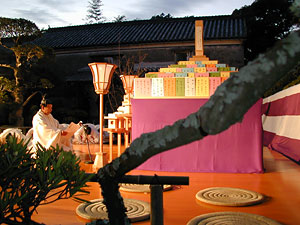 The chief priest opens the festival by reading a sacred tanka poem written by the divinity Susanoo no Mikoto.
The chief priest opens the festival by reading a sacred tanka poem written by the divinity Susanoo no Mikoto.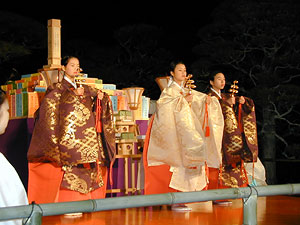 Three maidens with bell clusters purify the area.
Three maidens with bell clusters purify the area.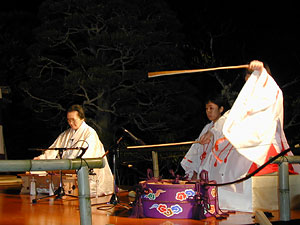 Two ancient instruments, a two-string koto and a bow drum, accompany the festival.
Two ancient instruments, a two-string koto and a bow drum, accompany the festival.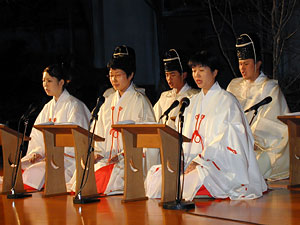 The chorus chants 46 poems one by one.
The chorus chants 46 poems one by one.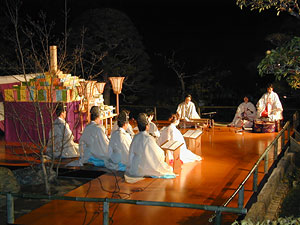 The setting, the lighting, the music and the cadence of the chanting create a magical moment.
The setting, the lighting, the music and the cadence of the chanting create a magical moment.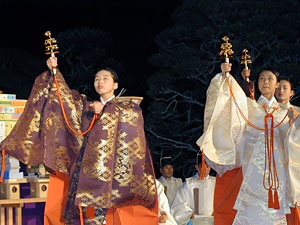 After every poem has been chanted the maidens return to close the festival.
After every poem has been chanted the maidens return to close the festival.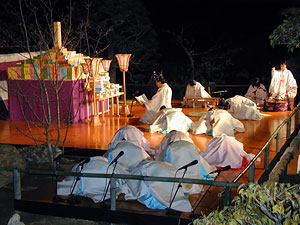 In closing, the chief priest recites the same sacred poem he used to open the Utamatsuri.
In closing, the chief priest recites the same sacred poem he used to open the Utamatsuri.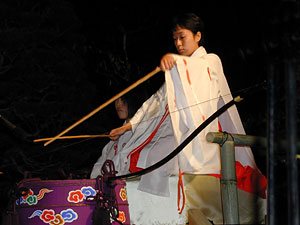 A closer view of the bow drum shows the bow and the drum.
A closer view of the bow drum shows the bow and the drum.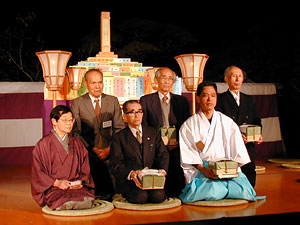 Tomoki Tada, in traditional dress on the far right of the front row, had the best poem as judged by a panel that included the Spiritual Leader.
Tomoki Tada, in traditional dress on the far right of the front row, had the best poem as judged by a panel that included the Spiritual Leader.New Contents Thu, May 20, 2010
- Oomoto participates in Sant’Egidio conference : Dialogue among religions and cultures : On divided island nation of Cyprus By Bill Roberts
- Photo Album : Portraits of three branches: Shoko, Tanegashima and Aomori By Bill Roberts
- Oomoto FAQ
- A Letter from Oomoto : Of mountains and myths By Bill Roberts
- Polyglot poem festival The Utamasturi is going international — what’s next? By Bill Roberts
- Ethics education program captures the spirit of Bankyo Dokon By Bill Roberts
- A Letter from Oomoto : A year’s worth of adventure in a summer of branch visits By Bill Roberts
- In Kumamoto, it’s all about water – and fire By Bill Roberts
- A speech by Nevada Taylor at the Kii Branch in Wakayama Prefecture on April 13, 2008.:An Encounter With Oomoto Through Aikido
- Utamatsuri, Poem Festival, in Tokyo(on April 17, 2008)
- A speech by Neil Ryan Walsh at the Kobe branch on Mar. 9th, 2008.:Planting the Seeds of the Soul
- Meeting with the Fifth Spiritual Leader of Oomoto, Madame Kurenai Deguchi by Neil Ryan Walsh
- A speech by Neil Ryan Walsh at the Nagoya branch on Feb. 17th, 2008.:The Japanese Arts beyond National Boundaries
- To the Oomoto branch in Nagoya: City of Eel and Toyota by Neil Ryan Walsh
- A Speech by Nissim Ben Shitrit, Ambassador of Israel on the occasion of the Oomoto Setsubun Grand Festival in Ayabe February 3rd, 2008 : Japan and Israel : Two Lands Balancing the Needs of Traditional Culture and Modern Life. r
- A permanent memorial to Onisaburo (A Speech at the Autumn Grand Festival , November 6, 2007 : )By James Parks Morton, Founder and Chair, Emeritus of The Interfaith Center of New York
- Israel, Palestine and the Power of Poetry(Oomoto believes small efforts can have lasting ripple effects on people and peace)By Bill Roberts
- “Something Great”(This genetics pioneer, a friend of Oomoto, offers a clue to the mystery of life)By Bill Roberts
- Kamishima Cleanup (Harima branch members regularly visit this sacred island to keep the shrine tidy)By Bill Roberts
- Kyotaro Deguchi was one of six recipients of the 2007 James Parks Morton Interfaith Award
What is Oomoto?
- What is Oomoto?
- Spirtual Centers
- Founders and Spiritual Leaders
- History
- Organization and activities
- Teachings and scriptures
- Art Works of Founders and Leaders
Opinions[Archive]
- Statement of regret for the outbreak of war against Iraq (March 20,2003)
- Jinrui Aizenkai dispatched the "Urgent Appeal for a World (Global) Crisis" on March 14.
Grappling with Bioethics[Archive]
- Oomoto’s support for abolishing the death penalty (12, June 2003)
- The Oomoto Foundation protests any birth of a human clone baby. (5, January 2003)
- OOMOTO'S VIEW REGARDING JAPAN’S PERMITION TO THE RESERCH OF HUMAN EMBRYONIC STEM CELLS (ES cells)(12, June 2000)
Vistor’s Review[Archive]
- A speech by Bill Roberts at the Oomoto branch in Hiroshima after its monthly service on March 18, 2007:Encounters with war and peace
- How Bankyo Dokon changed one life by Linda Macphee
- A speech by Bill Roberts at the Hokuriku (Kanazawa) branch on Dec. 3, 2006:Ritual and myth -an encounter with ‘divine madness’
- A speech by Bill Roberts at the Himeji Cultural Center on Feb. 25, 2007:Mesmerized by the Japanese Arts
- A speech by Bill Roberts at the Kobe branch on Feb. 11th, 2007.:There are just human tears and human joy
- A Speech on the occasion of the Oomoto Setsubun Grand Festival in Ayabe February 3rd, 2007 : Egypt's role in Middle East peace
- Keynote Speech for the 28th World Federation Japanese Religionists Conference for World Peace in Tokyo (at Kokugakuin University, Novermber 29, 2006):Vision for Peace in the Middle East By Dr. Munther S. Dajani, Professor Dean, Faculty of Arts, Al Quds University, Jerusalem
- A speech to the Kyoto branch:Spiritual adventures in researching Oomoto leaders
- A Speech at The Oomoto Foundation on Monday, November 6, 2006 : Jordan's role in Middle East By Samir Nouri, Ambassador of the Hashemite Kingdom of Jordan
- A letter from Oomoto:The Young People of Tottori
- A speech by Bill Roberts on the occasion of the dedication ceremony for the new shrine of Tottori Branch By Bill Roberts Oct. 8, 2006
- A speech by Bill Roberts at the Oomoto branch in Hiroshima after its monthly service on March 18, 2007:Encounters with war and peace
- How Bankyo Dokon changed one life by Linda Macphee
- A speech at Setsubun : A Portrait of Oomoto By Bill Roberts Feb. 3, 2006
- New Publication ! By Bill Roberts Feb. 3, 2006 A Portrait of Oomoto
you can read this book in html => http://www.jinruiaizenkai.jp/English/en-kolumno/en-bill/en-sugao/billbook1en.html
E-mail below to order brobert1@ix.netcom.com
Current Topics
- Prayer Offering and World Religious Forum II
- Living the art of dialogue
- Kyotaro Deguchi was one of six recipients of the 2007 James Parks Morton Interfaith Award
Books
Online Books
- Divine Signposts by Onisaburo DEGUCHI
- The Creation of Meaning by Hidemaru Deguchi
- Bankyo Dokon(Seventy years of Inter-Religious Activity at Oomoto)
- Nao Deguchi — A Biography of the Foundress of Oomoto
- The Great Onisaburo Deguchi published by Aiki News
- Bankyo Dokon Seventy Years of Inter-Religious Activity at Oomoto
- Insearch of Meaning
- Nao Deguchi A Biography of the Foundress of Oomoto
- A Portrait of Oomoto By Bill Roberts
Oomoto international Archive
- The History of Oomoto (Jan.– Mar. 1980 — Apr.– Jun. 1982)
- The Ancestors; Friends or Foes? (Apr.– Jun. 1987)
- Tsukinamisai; The Sabbath of Shinto (Jan.– Jun. 1983)
- The Poem Festival at Oomoto; An Ancient Rite Lives Again (Oct.– Dec. 1981)
- Purification of the Universe ; Oomoto's Setsubun Festival (Apr.– Jun. 1981)
Links
Flowers at Ten'on-kyo & Baisho-en (photographs)
Contact
All rights reserved : the Oomoto Foundation Produced by the Netinformational Commission
Since : Mar. 7.1998 Last Update : Thu, May 20, 2010
E-mail : webmaster@oomoto.or.jp
Top Page Nihongo Esperanto Português Roomazi



